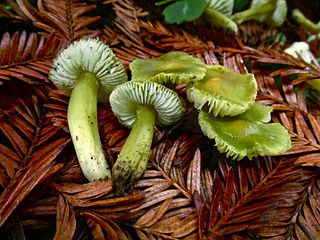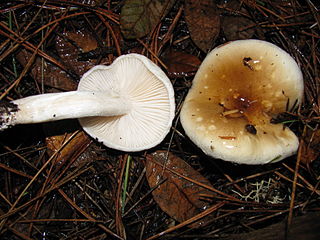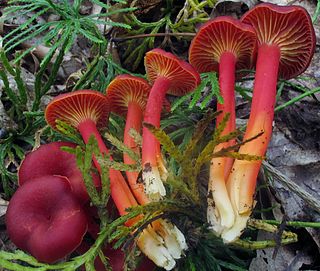
Gymnopilus luteofolius, known as the yellow-gilled gymnopilus, is a large and widely distributed mushroom that grows in dense clusters on dead hardwoods and conifers. It grows in late July to November in the east and in the winter on the west coast of North America. It has a rusty orange spore print and a bitter taste.

Hygrocybe virescens, commonly known as the lime-green waxy cap, is a species of agaric mushroom in the family Hygrophoraceae. The lime-green colored mushroom has a limited geographical distribution, having been reported only from California, Washington, and Mexico.

Hygrophorus subalpinus, commonly known as the subalpine waxycap, is a species of white snowbank fungus in the family Hygrophoraceae. Found in the mountains of western North America, it is found growing on the ground under conifers, usually near snowbanks.

Mycena overholtsii, commonly known as the snowbank fairy helmet or fuzzy foot, is a species of fungus in the family Mycenaceae. The mushrooms produced by the fungus are relatively large for the genus Mycena, with convex grayish caps up to 5 cm (2 in) in diameter and stems up to 15 cm (6 in) long. The gills on the underside of the cap are whitish to pale gray, and initially closely spaced before becoming well-spaced at maturity after the cap enlarges. The mushrooms are characterized by the dense covering of white "hairs" on the base of the stem. M. overholtsii is an example of a snowbank fungus, growing on well-decayed conifer logs near snowbanks, during or just after snowmelt. Formerly known only from high-elevation areas of western North America, particularly the Rocky Mountain and Cascade regions, it was reported for the first time in Japan in 2010. The edibility of the mushroom is unknown. M. overholtsii can be distinguished from other comparable species by differences in location, or spore size.

Plectania nannfeldtii, commonly known as Nannfeldt's Plectania, the black felt cup, or the black snowbank cup fungus, is a species of fungus in the family Sarcosomataceae. The fruit bodies of this species resemble small, black, goblet-shaped shallow cups up to 3 cm wide, with stems up to 4 cm long attached to black mycelia. Fruit bodies, which may appear alone or in groups on the ground in conifer duff, are usually attached to buried woody debris, and are commonly associated with melting snow. Plectania nannfeldtii is found in western North America and in Asia, often at higher elevations. Similar black cup fungi with which P. nannfeldtii may be confused include Pseudoplectania vogesiaca, P. nigrella, and Helvella corium.

Hygrophorus agathosmus, commonly known as the gray almond waxy cap or the almond woodwax, is a species of fungus in the family Hygrophoraceae. It was first described by Elias Magnus Fries in 1815; Fries gave it its current name in 1838. A widespread species, it is distributed in the United States, Europe, Africa, and India, and is found growing under spruce and pine in mixed forests. The fruit bodies are characterized by a light grayish cap that measures up to 8 cm (3.1 in) in diameter, waxy gills, a dry stem, and the distinct odor of bitter almonds. An edible but bland-tasting mushroom, extracts of the fruit bodies have been shown in laboratory tests to have antimicrobial activity against various bacteria that are pathogenic to humans.

Lactarius subflammeus, commonly known as the orange milk cap, is a species of fungus in the family Russulaceae. It is found in western North America in the late summer and fall and is especially common in the Pacific Northwest, where it grows on the ground near conifers like pine and spruce. The brightly colored fruit bodies, which are slimy or sticky, have scarlet caps when young that soon fade to brilliant orange. The stem—typically longer than the width of the cap—is also bright orange but the gills are whitish. The mushroom secretes a whitish latex when it is cut or injured.

Lactarius argillaceifolius is a species of fungus in the family Russulaceae. The mushrooms produced by the fungus have convex to flattened drab lilac-colored caps that are up to 18 cm (7.1 in) wide. The cream-colored gills are closely spaced together and extend slightly down the length of the stem, which is up to 9 cm (3.5 in) long by 3.5 cm (1.4 in) thick. The mushroom produces an off-white latex when injured that stains the mushroom tissue brownish.

Hygrophorus eburneus, commonly known as the ivory waxy cap or the cowboy's handkerchief, is a species of edible mushroom in the waxgill family of fungi. It is widespread in Europe and North America, and has also been collected in northern Africa. The fruit bodies are medium-sized, pure white, and when wet are covered in a layer of slime thick enough to make the mushroom difficult to pick up. The gills are broadly attached to the stem or running down it; as the family name suggests, they feel waxy when rubbed between the fingers. Like all Hygrophorus species, the fungus is mycorrhizal—a symbiotic association whereby the underground fungal mycelia penetrate and exchange nutrients with tree roots. They are common in a variety of forest types, where they grow on the ground in thickets or grassy areas. Hygrophorus eburneus is the type species of the genus Hygrophorus. A number of biologically active chemicals have been purified from the fruit bodies of the fungus, including fatty acids with bactericidal and fungicidal activity.

Hygrophorus bakerensis, commonly known as the Mt. Baker waxy cap, the brown almond waxy cap or the tawny almond waxy cap, is a species of fungus in the family Hygrophoraceae. It is characterized by its medium to large, relatively slender-statured fruit bodies with an almond odor, and growth often on or near rotting conifer wood. The slimy cap is brown in the center and cream to white near its curved edges. The gills and the stem are white, and in moist environments are often covered with droplets of a translucent liquid. The mushroom is known only from the United States, where it is common in coniferous forests throughout the Pacific Northwest. It was initially collected in Washington State on Mount Baker, a volcano. Although edible, the mushroom is not considered to be of high quality.

Hygrophorus marzuolus, commonly known as the March mushroom, is a species of fungus in the family Hygrophoraceae. It is known from Asia, Europe, and North America, where it grows on the ground in mixed forests at high elevations.

Hygrophorus purpurascens, commonly known as the purple-red waxy cap, is a species of agaric fungus in the family Hygrophoraceae. Its cap has a pink background color with streaks of purplish red overlaid, and mature gills have red spots.

Tricholoma vernaticum is an agaric fungus of the genus Tricholoma native to the Pacific Northwest region of the United States. The fungus was originally described in 1976 as a species of Armillaria when that genus was more inclusive; it received its current name twenty years later. The stout fruit bodies (mushrooms) have moist white to grayish caps, a membranous ring on the stipe, and an odor resembling cucumbers. Mycorrhizal with conifers, the fungus fruits in the spring or early summer, with its mushrooms appearing on the ground singly or in groups at high elevations, often at the edge of melting snowbanks. The edibility of the mushroom is unknown, but it has a strong unpleasant odor and a mealy taste.

Tubaria punicea is a rare species of agaric fungus in the family Tubariaceae. It is found on the west coast of North America, where it grows on the bases and in hollows of madrone.

Clitocybe albirhiza, commonly known as the snowmelt clitocybe, is a species of agaric fungus in the family Tricholomataceae. It is found in high-elevation locations in the western United States.

Ramaria magnipes is a coral fungus in the family Gomphaceae. It is found in western North America, where it fruits on the ground in mixed forests.

Boletus subluridellus is a species of bolete fungus in the family Boletaceae. Described as new to science in 1971 by American mycologists, the bolete is found in the eastern United States and Canada. It grows on the ground in coniferous and mixed forests in a mycorrhizal association with deciduous trees, especially oak. The fruit bodies (mushrooms) have orangish-red, broadly convex caps that are up to 10 cm (3.9 in) in diameter, with small, dark reddish pores on the underside. The pale yellow stipe measures 4–9 cm (1.6–3.5 in) long by 1.5–2.3 cm (0.6–0.9 in) thick. All parts of the fruit body will quickly stain blue when injured or touched.

Pholiota nubigena, commonly known as the gastroid pholiota or the bubble gum fungus, is a species of secotioid fungus in the family Strophariaceae. It is found in mountainous areas of the western United States, where it grows on rotting conifer wood, often fir logs. It fruits in spring, often under snow, and early summer toward the end of the snowmelt period in high mountain forests. Fruit bodies appear similar to unopened mushrooms, measuring 1–4 centimetres tall with 1–2.4 cm diameter caps that are whitish to brownish. They have a short but distinct whitish stipe that extend through the internal spore mass (gleba) of the fruit body into the cap. The gleba consists of irregular chambers made of contorted gills that are brownish in color. A whitish, cottony partial veil is present in young specimens, but it often disappears in age and does not leave a ring on the stipe.

Hygrophorus caeruleus is a rare species of agaric fungus in the family Hygrophoraceae. Found in the western United States, the mushroom is characterized by its stout fruit body including blue-tinted cap margin and stipe, blue-grey to bluish green gills, and odor of rancid meal.

Hygrocybe appalachianensis, commonly known as the Appalachian waxy cap, is a gilled fungus of the waxcap family. It is found in the eastern United States, where it fruits singly, in groups, or clusters on the ground in deciduous and mixed forests. The species, described in 1963 from collections made in the Appalachian Mountains, was originally classified in the related genus Hygrophorus. It was transferred to Hygrocybe in 1998, in which it has been proposed as the type species of section Pseudofirmae.




















